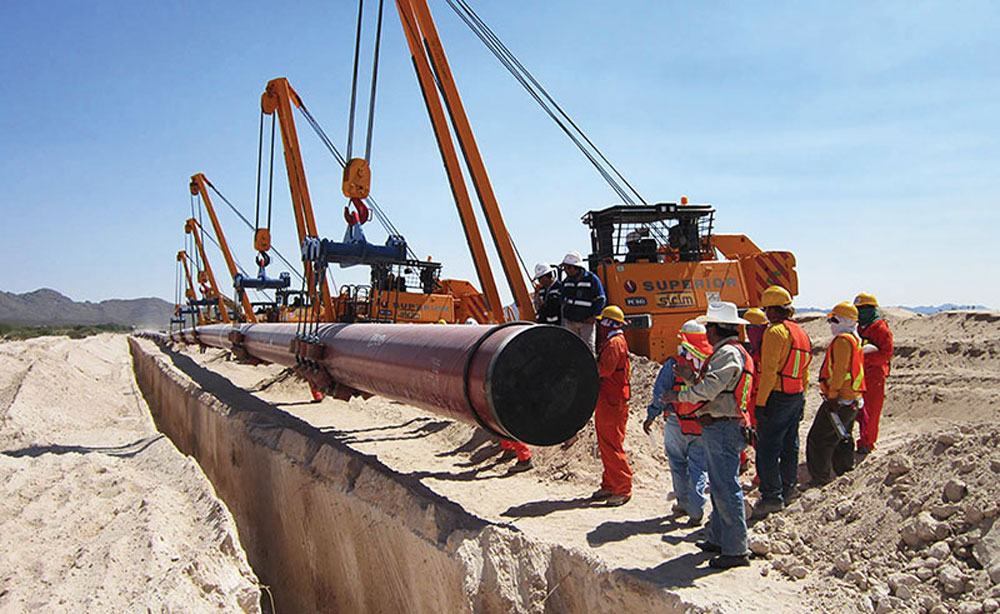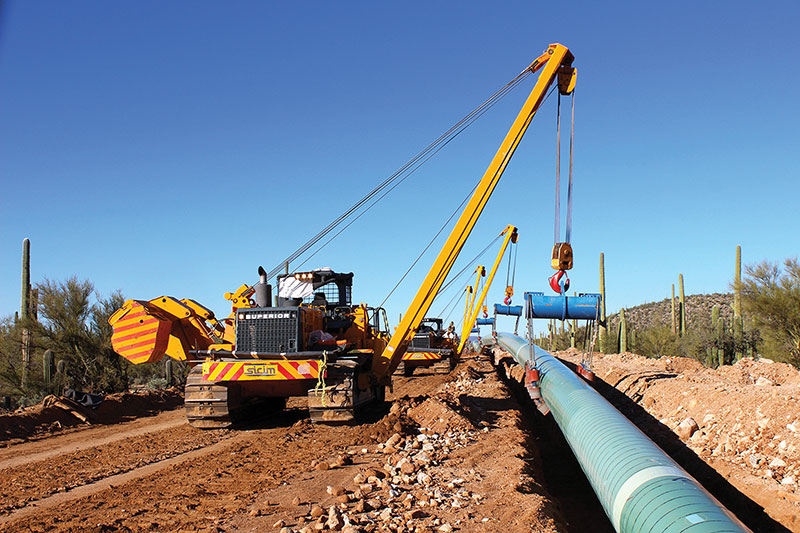August 2024, Vol. 251, No. 8
Features
Mexico Spotlight: Nation Moving Toward Role as LNG Exporter with Expansion Projects
[To explore the full digital edition, including the Page Raft version of this article, click here.]
By Pipeline & Gas Journal Staff
(P&GJ) — In an ongoing effort, Mexico is developing 31 mtpa of LNG export capacity on its west coast, with most of the feed expected to come through imports — primarily from the United States.

If Mexico follows through with construction of all its proposed LNG gas export projects, it will become the fourth-largest LNG shipper in the world.
With most of the planned terminals expected to make use of spare capacity on existing pipelines, such as the Topolobampo, the Samalayuca Sasabe and the Sonora, it appears that one of the largest potential new pipelines — for a while, anyway — will be ONEOK’s 155-mile Saguaro Connector.
The Saguaro would move natural gas to Mexico Pacific’s 14.1 mtpa Saguaro LNG export facility — still in development — which awaits sanctioning of a proposed LNG export terminal on Mexico’s Gulf of California.
With the bulk of the gas to the coast originating at the Waha gas hub in Texas — via either the El Paso Pipeline System, or the Comanche Trail and Roadrunner Gas Transmission Pipelines — U.S. regulators approved a cross-border pipeline in February that would export about 2.8 Bcfd of natural gas from Texas to Mexico Pacific’s Saguaro LNG export plant.
The 48-inch pipeline would originate at the Waha Hub in Pecos County, Texas, and connect at the border with a planned Mexican pipeline that would deliver natural gas to a new export facility on the Gulf of California coast.
While the details of the Mexican pipeline haven’t been announced, its destination has — Saguaro LNG Phase II would add an additional 4.7 mtpa of capacity to the 9.4-mtpa Phase I facility in Puerto Libertad, Sonora.
The first phase has a start date of 2025, having reached a final investment decision (FID), according to Gulf Energy Information’s Global Energy Infrastructure (GEI). Saguaro LNG’s operator, Mexico Pacific, has not announced a start date for Phase II, which would also source natural gas from New Mexico’s San Juan Basin.

While a potential boom for U.S. producers, the Mexican LNG terminals will be competing with numerous U.S. LNG export facilities that are either planned, under construction or in various stages of expansion.
Obviously, the buildout still comes as news to midstream, engineering and construction companies from the U.S. and Canada, as well as to U.S. LNG producers with potential stakes in the Mexico facilities or pipelines that supply them.
But midstream, engineering and construction companies from the U.S. and Canada are poised to benefit, as are U.S. LNG producers with potential stakes in the Mexico facilities or pipelines that supply them.
In additional activity, Gasoducto Centauro del Norte has signed an agreement with Mexico’s Federal Electricity Commission to develop, build and operate a 258-mile gas pipeline in the north of the country.
Background on Projects
Coatzacoalcos LNG – In November of 2022, CFE called for expressions of interest in an onshore liquefaction plant in the port of Coatzacoalcos in Vera Cruz. The plant would have a capacity of 4.5 mtpa.
In February 2023, the head of CFE international said that the project would be tendered soon and would replace the LNG project in Salinas Cruz. As of February, the project is expected to export gas to Europe.
CFE said it would provide natural gas to the project via pipeline, a site for the development of the project, assistance with permits and assistance with necessary pipeline connections. CFE also said it may consider partial ownership in the project.
Amigo LNG – In 2020, LNG Alliance received FERC authorization to export American gas through Amigo LNG, a planned LNG liquefaction plant Guaymas, Sonora. FEED commenced on the project in 2020 as well. As of February, Amigo LNG planned to use two 3.6 mtpa-capacity trains for a total capacity of 7.2 mtpa. Gas for this project would be delivered via existing pipelines.
Produced LNG from Amigo is expected to target Asian markets. In April of 2022, LNG Alliance said project costs were expected to be $2.1 billion. The project targets start-up in the first quarter of 2026.
Vista Pacifico LNG – Vista Pacifico LNG is a proposed 3–4 mtpa liquefaction project led by Sempra and expected to be placed next to an existing Sempra refined products terminal in Topolobampo, Mexico. In December 2022, FERC authorized Vista Pacifico to re-export up to 200 Bcf/a of LNG from U.S.-sourced natural gas. Developers are targeting a start-up date in 2025.
There is also a drive toward expanded LNG export capacity on Mexico’s East Coast.
Mexico FLNG – New Fortress Energy (NFE) and CFE are developing three floating LNG (FLNG) units off the Atlantic coast of Altamira. NFE is the operator, while CFE is providing the feedstock, using existing pipelines. The NFE Fast LNG units are to have a capacity of 1.4 mtpa each.
The first FLNG unit was scheduled for deployment to Altamira this summer, with production start-up planned for the third quarter this year. In May, NFE said it had signed a letter of intent with CFE to install the second and third Fast LNG units onshore, at the site of the existing Altamira LNG import terminal, converting it to an export terminal in the process.
Natural gas for the units is being sourced via the Brownsville and Sur de Texas-Tuxpan pipelines. Fluor is leading engineering for the project, with construction by Kiewit.
President Andres Manuel Lopez Obrador has been a strong advocate of Mexico’s push from zero commercial LNG exports to the world’s No. 4 producer, behind only the United States, Australia and Qatar.
Internal Supply
To address some of the growing demand for natural gas in the Yucatan Peninsula, the Federal Electricity Commission (CFE) and Energía Mayakan, from Engie, signed an agreement for the expansion of the Mayakan gas pipeline.
The expansion of Mayakan will allow the natural gas transportation capacity to more than double from 250 MMcfd (7 MMcmd) to 567 MMcfd (16 MMcmd), through the construction of a 435-mile (700-km) gas pipeline.
In addition, it will promote the interconnection with the Puerta del Sureste gas pipeline, which provides natural gas by sea from Brownsville, Texas, to Tuxpan and Coatzacoalcos, in Veracruz; and Paraíso, Tabasco, which will interconnect with Mayakan in Cactus, Chiapas.
Engie’s project would take gas from state oil company Pemex’s Cactus processing plant in the state of Chiapas and direct it to Valladolid, in the state of Yucatán.







Comments